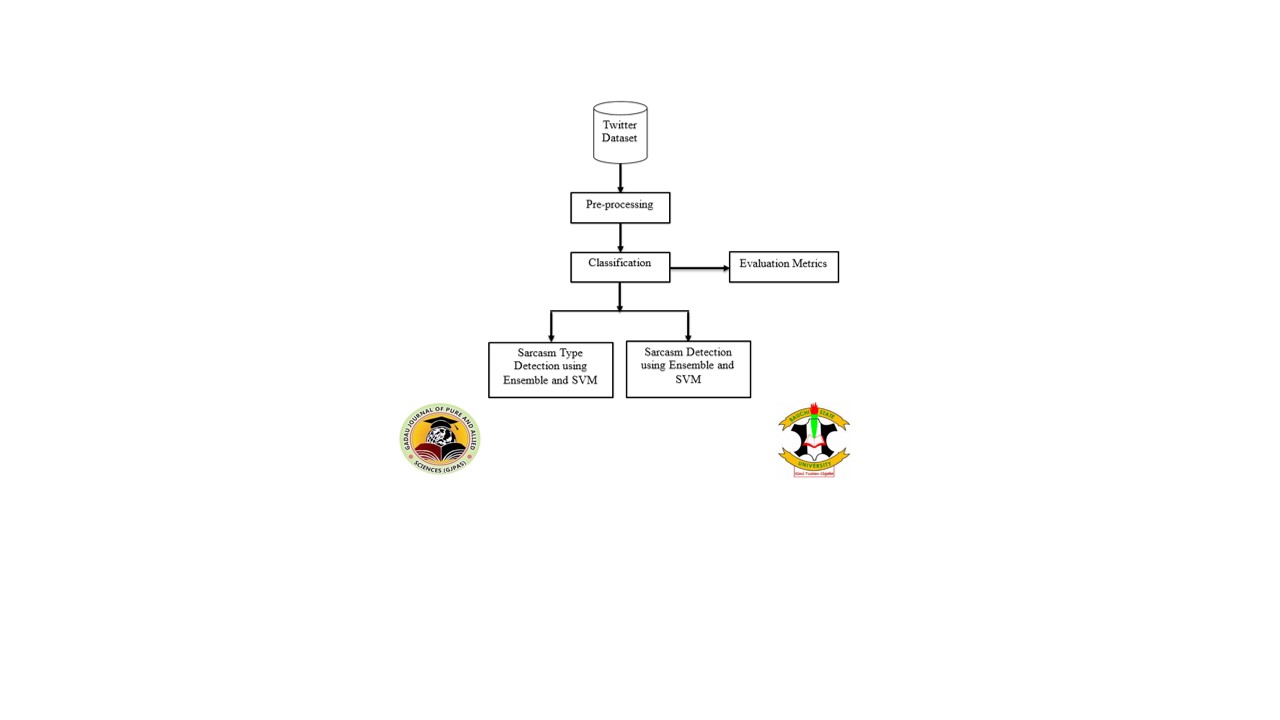Sentiment analysis of sarcasm detection in social media
DOI:
https://doi.org/10.54117/gjpas.v2i1.72Keywords:
Sarcasm, Sentiment Analysis, Machine Learning, Neural Network, TwitterAbstract
When people talk or write more especially on social media, they tend to sometimes, flip the polarity of their expressions. Oftentimes, this change of mood affects the accuracy of the sentiment analysis. Sarcasm is a sophisticated form of irony widely used in social networks and micro blogging websites and is usually a type of sentiment where person speaks the contradictory of what individual word means, expressing gloomy feelings applying positive words. However, it is hard even for humans to recognize. Hence, sarcastic expressions play a vital role in the outcome of automatic sentiment detection in sentiment analysis. To improve on the performance of automatic detection of sentiments in social media networks, there is need for sarcastic statements to be recognised and classify correctly. Sentiment Analysis is a method for identifying people’s opinion, attitude, sentiment, and emotion towards any specific target such as individuals, events, topics, product, organizations, services etc. This paper proposed an ensemble classification method having base classifiers as Random Forest, K-Nearest Neighbour and Naive Bayes for detecting sarcasm using lexical, pragmatic, linguistic incongruity and context incongruity features. The same ensemble method and Support Vector Machines (SVM) were used to identify the sarcasm types so as to diagnose the mood of the users. We report the results and present a comparative evaluation of the ensemble method and SVM classifiers for sarcasm and sarcasm type detection indicating their suitability for the task. The results obtained from the set of experiments conducted indicate the reliability of our approach.
References
Anukarsh, G. P., Sanjana, S., Skanda M. B., and Harish, B. S. (2017). “Sentiment Analysis for Sarcasm Detection on Streaming Short Text Data”, 2nd International Conference on Knowledge Engineering and Applications, IEEE, 2017.
Ashwin, R., Reza, Z., and Huan, L. (2015) “Sarcasm Detection on Twitter: A Behavioral Modeling Approach”, Proceedings of 8th ACM International Conference on Web Search and Data Mining, P. 97-101, 2015.
Bamman, D., and Smith, N. (2015). Contextualized Sarcasm Detection on Twitter Copyright © 2015, Association for the Advancement of Artificial Intelligence (www.aaai.org)
Baruah, A., Arup, U., and Frank H. (2020). "Context-aware sarcasm detection using BERT." Proceedings of the Second Workshop on Figurative Language Processing. 2020.
Bhakuni, M., Kumar K., Sonia, K., Iwendi, C., and Singh, A. “Evolution and Evaluation: Sarcasm Analysis for Twitter Data Using Sentiment Analysis,” J. Sensors, vol. 2022, 2022, doi: 10.1155/2022/6287559.
Du, X., James T., and Yu, W. (2022). "An effective sarcasm detection approach based on sentimental context and individual expression habits." Cognitive Computation 14.1 (2022): 78-90.
Geng, Q., Feng, A., Zing I. (2022). "Multimodal sentiment analysis based on multi-head self-attention and convolutional block attention module." 2022 5th International Conference on Advanced Electronic Materials, Computers and Software Engineering (AEMCSE). IEEE, 2022.
Kreuz, R. J., and Roberts, R. M. (1995). “Two Cues for Verbal Irony: Hyperbole and the Ironic Tone of Voice”, Metaphor and Symbol, Vol. 10, No. 1, P. 21-31, 1995.
Kumar, S., Raji, B., Avinash, U. (2020). "Sarcasm detection using multi-head attention based bidirectional LSTM." IEEE Access 8 (2020): 6388-6397.
Liebrecht, F. K. (2013). The perfect solution for detecting sarcasm in tweets #not Proceedings of the 4th Workshop on Computational Approaches to Subjectivity, Sentiment and Social Media Analysis, P. 29–37, Atlanta, Georgia, 14 June 2013.
Manoj, Y., Manohar, P. (2017). “Improvement Sarcasm Analysis using NLP and Corpus based Approach”, International Conference on Intelligence Computing and Control Systems (ICICCS), IEEE, 2017.
Mondher, B., and Tomoaki, O. (2017). A pattern-based approach for sarcasm detection on twitter. IEEE. Transl. 2017.
Ortega-Bueno, R., Rangel, F., Hernandez-Farıas, D., Rosso, P., Montes-y-Go´mez, M., Medina-Pagola, J.E. (2019). Overview of the task on irony detection in Spanish variants. In: Proceedings of the Iberian languages evaluation forum (IberLEF 2019), co-located with the 34th conference of the Spanish Society for natural language processing (SEPLN 2019).
Paras D., Tanupriya, C., Rajat, M., and Praveen K. (2017). Automatic sarcasm detection using feature selection. In 2017 3rd International Con- ference on Applied and Theoretical Computing and Communication Technology (iCATccT), P. 29-34. IEEE, 2017.
Pornima, G. and Leena R. (2017) Sarcasm detection of non# tagged statements using mlp-bp. In 2017 International Conference on Advances in Computing, Com- munication and Control (ICAC3), P. 1-4. IEEE, 2017.
Prasad, N., and Anukarsh G. (2017). "Sentiment analysis for sarcasm detection on streaming short text data." Knowledge Engineering and Applications (ICKEA), 2017 2nd International Conference on. IEEE, 2017.
Razali, M. D., Saifullah, G., and Hamis, J. (2020). "Sarcasm detection using deep learning with contextual features." IEEE Access 9 (2021): 68609-68618.Ren, Lu, et al. "Sarcasm detection with sentiment semantics enhanced multi-level memory network." Neurocomputing 401 (2020): 320-326.
Santosh, K. B., Korra S. B., and Rahul R. (2017). Context-based sarcasm detection in hindi tweets. In 2017 Ninth International Conference on Advances in Pattern Recognition (ICAPR), P 1-6. IEEE, 2017.
Shrivastava, K., Mayank, S., and Shishir, K. (2021). "A pragmatic and intelligent model for sarcasm detection in a social media text." Technology in Society 64 (2021): 101489.
Shubhadeep, M., and Pradip, K. B. (2017). Sarcasm detection in microblogs using naive bayes and fuzzy clustering. Technology in Society, (48) P. 19-27, 2017.
Srivastava, K., Himani, L., and Hilad D. (2020). "A novel hierarchical BERT architecture for sarcasm detection." Proceedings of the Second Workshop on Figurative Language Processing. 2020.
Wu, T., Yang, S., and Sing, J. (2021). "Modeling incongruity between modalities for multimodal sarcasm detection." IEEE MultiMedia 28.2 (2021): 86-95.

Downloads
Published
Issue
Section
License
Copyright (c) 2023 Gadau Journal of Pure and Allied Sciences

This work is licensed under a Creative Commons Attribution 4.0 International License.

